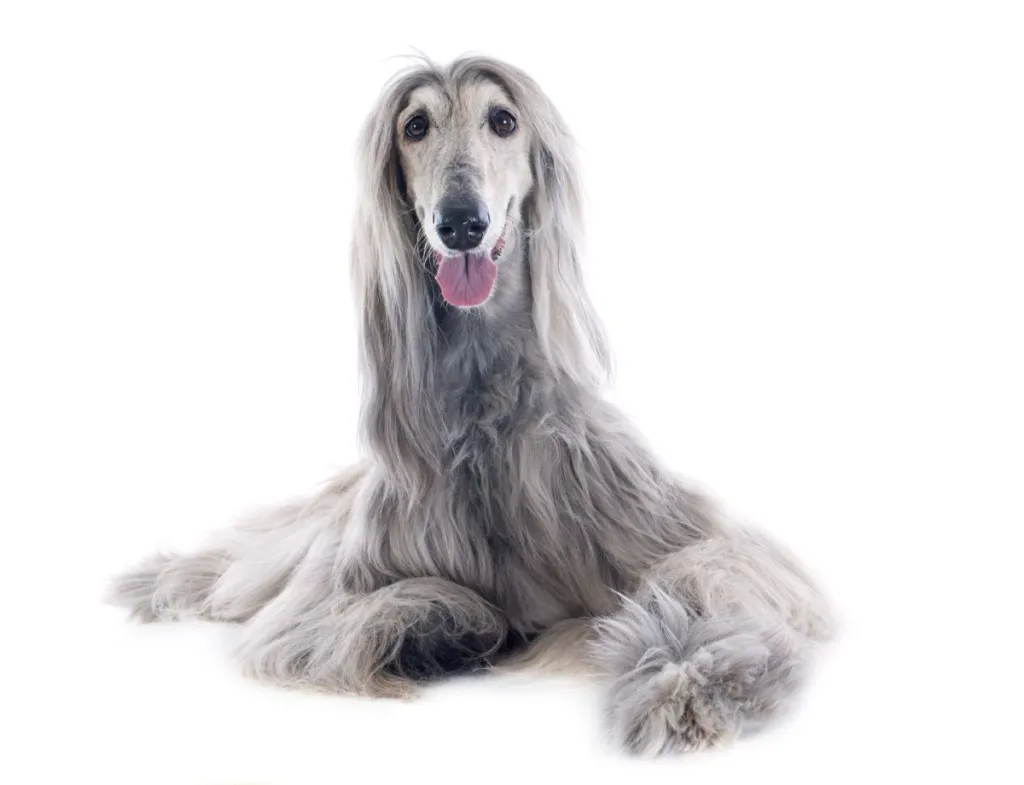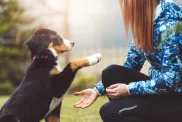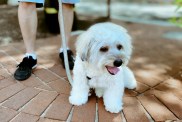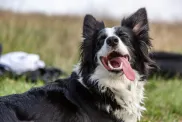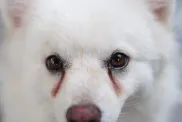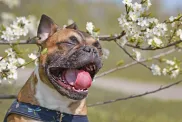The Afghan Hound is a majestic sight with its long, flowing hair and piercing eyes. Known for their independence, intelligence, and loyalty, they are a very old dog breed, with a history dating back thousands of years. The Bedouin people of Afghanistan bred these dogs to hunt gazelle and other small game in the harsh terrain of the Afghan mountains. Afghan Hounds were not only used as war dogs by the Afghan army, but they were also often depicted in historical art and literature. Today, they are still popular pets, but also used in dog shows and other competitions.
If you are considering bringing an Afghan Hound into your home, be sure to do your research and find a reputable breeder. While they are wonderful dogs, they require a special kind of owner. They are not the best choice for apartment living, as they need plenty of space to run and play.
Quick Facts
- Origin: Afghanistan
- Size: Afghan Hounds are large dogs, typically weighing between 50 and 60 pounds and standing 26 to 28 inches tall at the shoulder.
- Lifespan: 10-13 years.
- Grooming: The Afghan Hounds’ long, thick coat requires daily brushing. They are also prone to matting, so it is important to brush them regularly.
- Health: They are prone to some health problems, such as hip dysplasia, eye problems, and allergies.
- They are relatively rare dogs, with only about 2,000 registered in the United States each year.
- Due to their sighthound heritage, Afghan Hounds excel in lure coursing, a sport that simulates the chase of live game using a mechanical lure. This allows them to showcase their natural instincts and athleticism.
- In the Season 33 Episode 2 of “The Simpsons” entitled “Bart’s in Jail,” Homer hallucinates an Afghan Hound.
Afghan Hound Pictures
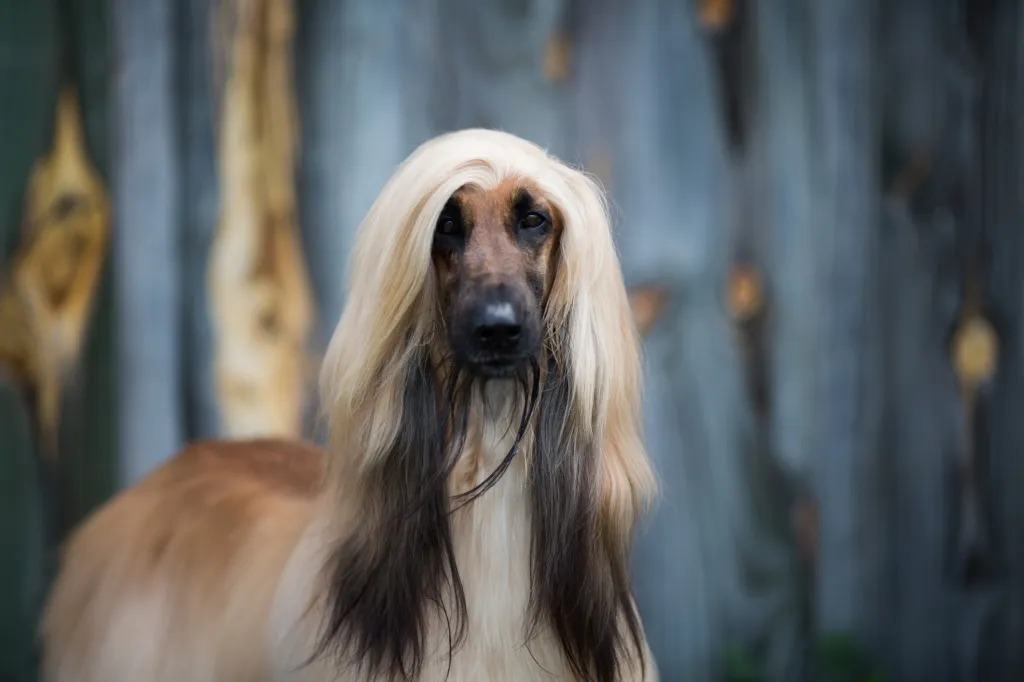
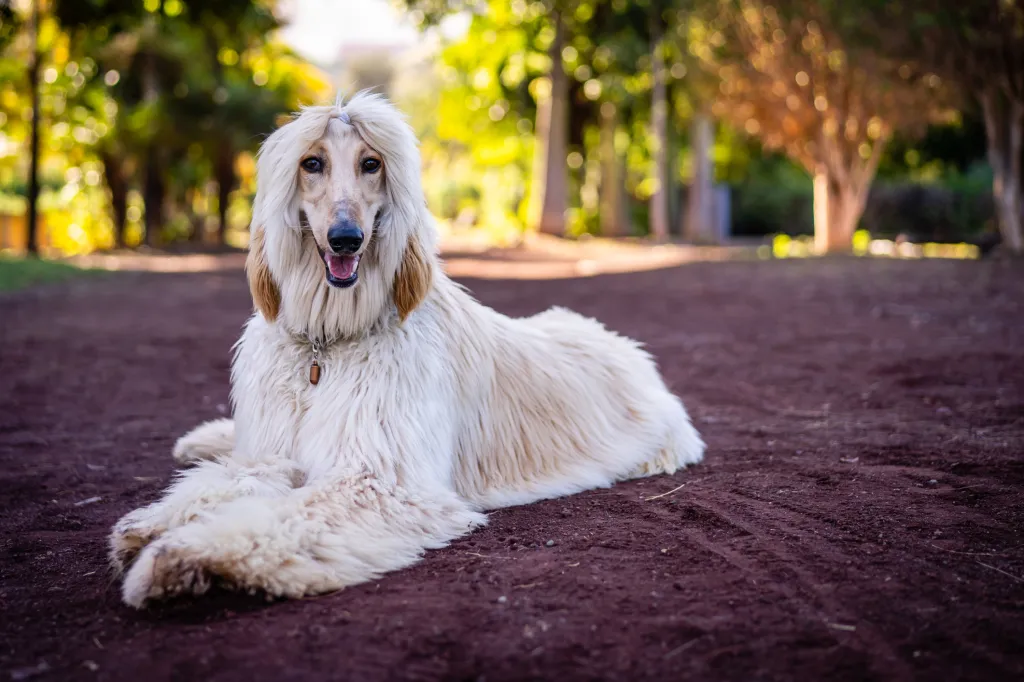
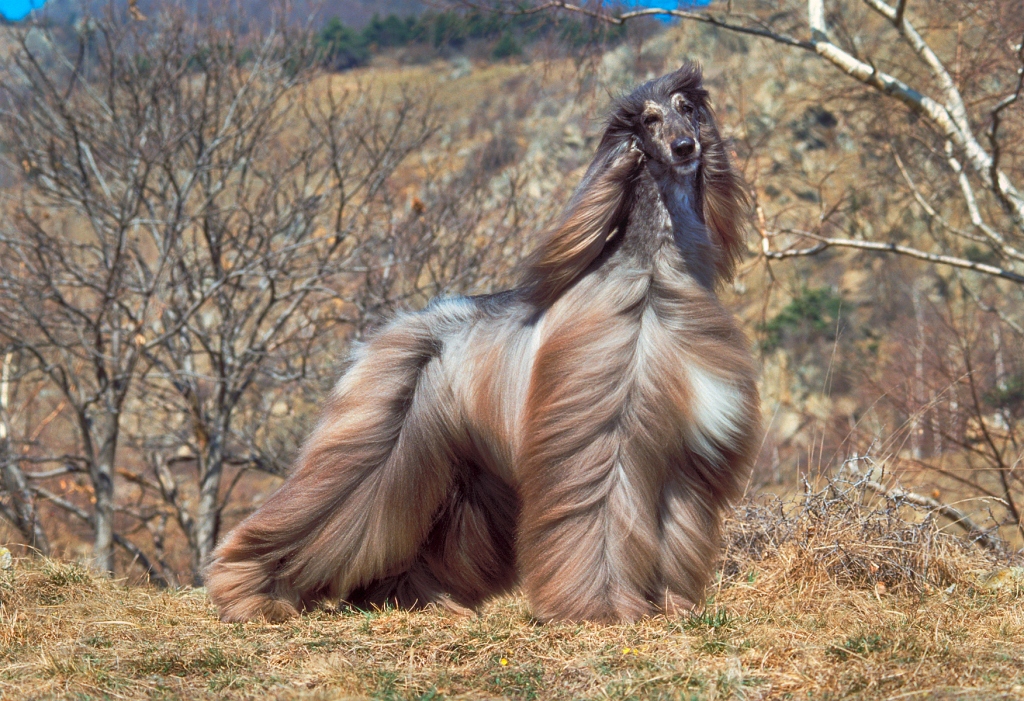
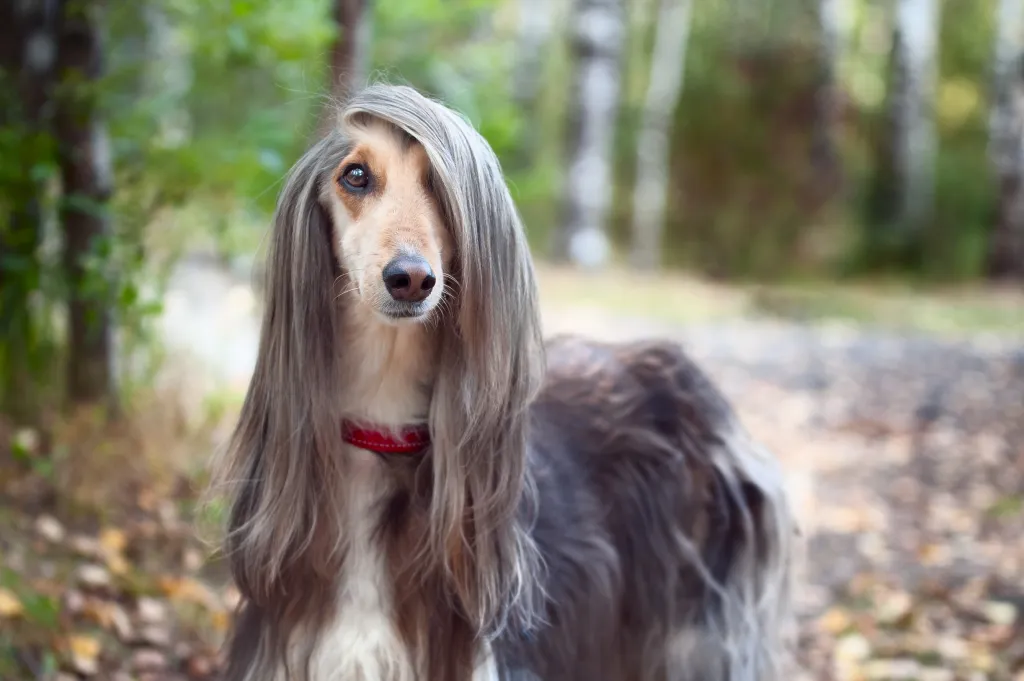
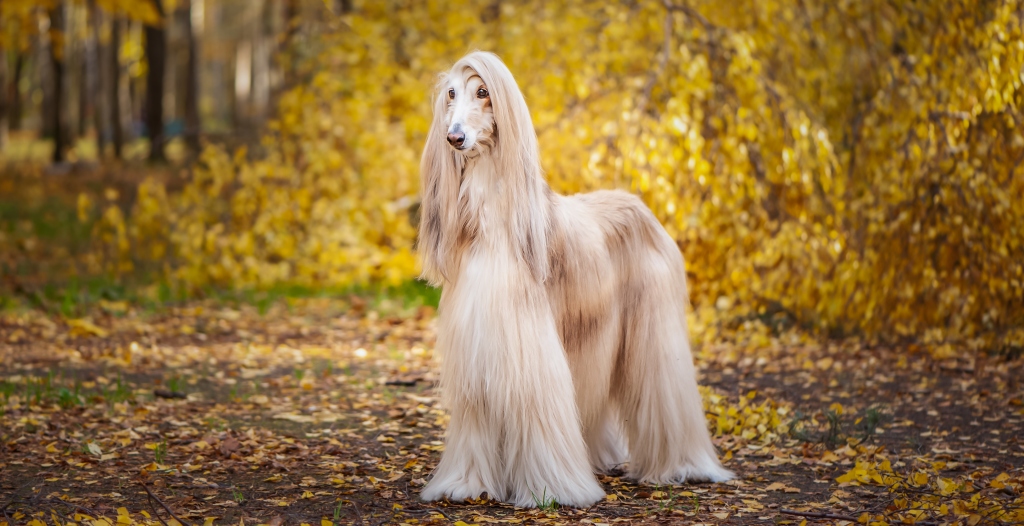
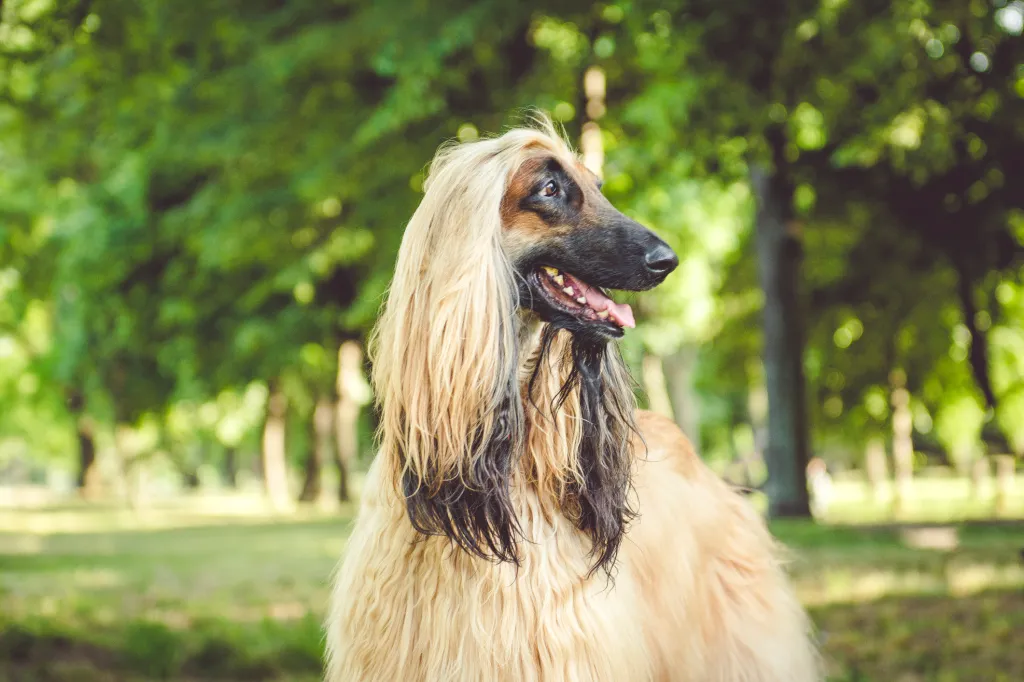
Adaptability
-
Adapts Well To Apartment Living
Looking for the best dog for your apartment? Contrary to popular belief, the suitability of dogs who adapt well to apartment living goes beyond its size. Apartment dwellers have a myriad of dog breeds to choose from as potential companions, with various factors to consider. Some large breeds can adapt well to apartment living and have lower activity levels. Others may require more space and possess higher energy levels. On the other hand, certain small dog breeds with abundant energy can still find contentment with indoor playtime or brisk walks.
However, when selecting a dog that adapts well apartments, it is essential to prioritize your neighbors. Opting for a pet that doesn’t excessively bark and behaves politely when encountering others in shared spaces like is crucial for maintaining a harmonious apartment environment.
In high-rise settings, it’s worth noting that numerous small dogs may exhibit a propensity for high energy and frequent barking. This makes them less suitable for apartment living. Therefore, desirable qualities in an apartment dog encompass being quiet, low-energy, and displaying polite behavior towards other residents.
Factors To Consider When Choosing A Dog For An Apartment
When considering dogs that adapt well to apartments, size alone should not be the sole determinant. Apartment dwellers have a wealth of dog breeds to choose from as potential furry companions. It’s important to remember that the size of your living space is just one factor to consider. While some larger breeds can adapt well to apartment living, with lower, others may require more space and have higher energy levels, making them less suitable for smaller apartments. Conversely, certain small dog breeds with higher energy levels can still thrive in apartments, finding contentment through indoor playtime or brisk walks. However, it is crucial to consider your neighbors’ comfort when selecting a dog. Opt for a pet that doesn’t bark excessively and behaves politely when interacting with others in shared spaces.
Therefore, it’s important to prioritize qualities such as being quiet, low-energy, calm indoors, and exhibiting good manners when living in close proximity to other residents. By considering these factors, you can find a dog that will adapt well to apartment living and create a harmonious living environment for everyone involved.
-
Good For Novice Owners
Some dogs are simply easier than others; they take to training better and are fairly easygoing. They’re also resilient enough to bounce back from your mistakes or inconsistencies.
Dogs who are highly sensitive, independent thinking, or assertive may be harder for a first-time dog parent to manage. You’ll get your best match if you take your dog-owning experience into account as you choose your new pooch.
If you’re new to dog parenting, take a look at 101 Dog Tricks and read up on how to train your dog!
-
Sensitivity Level
Some dogs will let a stern reprimand roll off their backs, while others take even a dirty look to heart. Low-sensitivity dogs, also called “easygoing,” “tolerant,” “resilient,” and even “thick-skinned,” can better handle a noisy, chaotic household, a louder or more assertive owner, and an inconsistent or variable routine. Do you have young kids, throw lots of dinner parties, play in a garage band, or lead a hectic life? Go with a low-sensitivity dog.
-
Tolerates Being Alone
Some breeds bond very closely with their family and are more prone to worry or even panic when left alone by their owner. An anxious dog can be very destructive–barking, whining, chewing, and otherwise causing mayhem. These breeds do best when a family member is home during the day or if you can take the dog to work.
-
Tolerates Cold Weather
Breeds with very short coats and little or no undercoat or body fat, such as Greyhounds, are vulnerable to the cold. Dogs with a low cold tolerance need to live inside in cool climates and should have a jacket or sweater for chilly walks. You can find a great jacket for your dog here!
-
Tolerates Hot Weather
Dogs with thick, double coats are more vulnerable to overheating. So are breeds with short noses, like Bulldogs or Pugs, since they can’t pant as well to cool themselves off. If you want a heat-sensitive breed, your dog will need to stay indoors with you on warm or humid days, and you’ll need to be extra cautious about exercising your dog in the heat.
All-around friendliness
-
Affectionate With Family
When it comes to unconditional love and unwavering loyalty, few animals can rival the affectionate nature of dogs. These remarkable creatures have earned their reputation as man’s best friend, and many breeds are particularly renowned for their love and devotion to their families. With their warm hearts and wagging tails, affectionate family dogs enrich the lives of their owners in countless ways.
One such breed known for its affectionate demeanor is the Golden Retriever. With their gentle temperament and friendly disposition, Golden Retrievers form deep bonds with their families. They eagerly participate in family activities, whether it’s a game of fetch in the yard or cuddling on the couch during a movie night. Their expressive eyes and ever-wagging tails are a testament to the joy they feel in the presence of their loved ones.
Another family-favorite breed is the Labrador Retriever. Renowned for their playful and patient nature, Labradors are excellent companions for children and adults alike. They readily engage in playtime with the kids, showcasing their boundless energy and enthusiasm. But when the day winds down, they seamlessly transition into loving and gentle cuddle buddies, comforting their family members with their warm presence.
Beyond specific breeds, mixed-breed dogs also have a special place in the hearts of families seeking affectionate companions. The shelter dogs, in particular, form deep connections with their adoptive families. They seem to understand the second chance they’ve been given and repay it with endless love and gratitude.
How To Know If A Dog Is Good With Families
The affectionate nature of family dogs extends beyond play and cuddles. Dogs have a remarkable ability to sense their owner’s emotions, offering comfort and support during difficult times. Whether it’s a wagging tail after a long day at work or a sympathetic nuzzle during moments of sadness, they prove time and again that they are attuned to their family’s needs.
It is important to note that not all dogs of the same breed will be equally affectionate. Some dogs may be more independent or aloof, while others may be more clingy or demanding of attention. The best way to find out how affectionate a dog is is to meet them in person and interact with them.
-
Kid-Friendly
Being gentle with children, sturdy enough to handle the heavy-handed pets and hugs they can dish out, and having a blasé attitude toward running, screaming children are all traits that make a kid-friendly dog. You may be surprised by who’s on that list: Fierce-looking Boxers are considered good with children, as are American Staffordshire Terriers (which are considered Pit Bulls). Small, delicate, and potentially snappy dogs such as Chihuahuas aren’t always so family-friendly.
**All dogs are individuals. Our ratings are generalizations, and they’re not a guarantee of how any breed or individual dog will behave. Dogs from any breed can be good with children based on their past experiences, training on how to get along with kids, and personality. No matter what the breed or breed type, all dogs have strong jaws, sharp pointy teeth, and may bite in stressful circumstances. Young children and dogs of any breed should always be supervised by an adult and never left alone together, period.
-
Dog Friendly
Friendliness toward dogs and friendliness toward humans are two completely different things. Some dogs may attack or try to dominate other dogs, even if they’re love-bugs with people; others would rather play than fight; and some will turn tail and run. Breed isn’t the only factor. Dogs who lived with their littermates and mother until at least six to eight weeks of age and who spent lots of time playing with other dogs during puppyhood, are more likely to have good canine social skills.
-
Friendly Toward Strangers
Stranger-friendly dogs will greet guests with wagging tails and nuzzles; others are shy, indifferent, or even aggressive. However, no matter what the breed, a dog who was socialized and exposed to lots of different types, ages, sizes, and shapes of people as a puppy will respond better to strangers as an adult. Remember that even friendly dogs should stay on a good, strong leash like this one in public!
Health And Grooming Needs
-
Amount Of Shedding
If you’re going to share your home with a dog, you’ll need to deal with some level of dog hair on your clothes and in your house. However, shedding does vary greatly among the breeds. Some dogs shed year-round, some “blow” seasonally, some do both, and some shed hardly at all. If you’re a neatnik, you’ll need to either pick a low-shedding breed or relax your standards. To help keep your home a little cleaner, you can find a great de-shedding tool here!
-
Drooling Potential
Drool-prone dogs may drape ropes of slobber on your arm and leave big, wet spots on your clothes when they come over to say hello. If you’ve got a laid-back attitude toward slobber, fine; but if you’re a neatnik, you may want to choose a dog who rates low in the drool department.
-
Easy To Groom
Some breeds are brush-and-go dogs; others require regular bathing, clipping, and other grooming just to stay clean and healthy. Consider whether you have the time and patience for a dog who needs a lot of grooming, or the money to pay someone else to do it.
-
General Health
Due to poor breeding practices, some breeds are prone to certain genetic health problems, such as hip dysplasia. This doesn’t mean that every dog of that breed will develop those diseases; it just means that they’re at an increased risk.
If you’re adopting a puppy, it’s a good idea to find out which genetic illnesses are common to the breed you’re interested in. You may also want to ask if your shelter or rescue has information about the physical health of your potential pup’s parents and other relatives.
-
Potential For Weight Gain
Some breeds have hearty appetites and tend to put on weight easily. As in humans, being overweight can cause health problems in dogs. If you pick a breed that’s prone to packing on pounds, you’ll need to limit treats, make sure they get enough exercise, and measure out their daily food servings into regular meals rather than leaving food out all the time.
Ask your vet about your dog’s diet and what they recommend for feeding your pooch to keep them at a healthy weight. Weight gain can lead to other health issues or worsen problems like arthritis.
-
Size
Get ready to meet the giants of the doggy world! Large dog breeds aren’t just big balls of fluff, they’re like loving, oversized teddy bears on a mission to steal your heart. Need some convincing? Let’s dive into the awesome benefits of owning one!
First things first, these pooches are a living security system! With their impressive size and thunderous barks, they’ll have any would-be intruder running for the hills. Talk about peace of mind! Plus, who needs an alarm when you’ve got a furry giant protecting your castle?
But that’s not all. Large dog breeds are all about loyalty and devotion. They’ll stick by your side through thick and thin, becoming your most dedicated bestie. Their love knows no bounds! When you have a giant fluffball showing you unconditional love, you’ll feel like the luckiest human on the planet.
Now, let’s talk about their talents. These big fellas are the ultimate working partners. With brains and brawn, they’re up for any challenge. From search and rescue missions to lending a helping paw to those in need, these dogs are superheroes in fur coats. They’ll make you proud every step of the way!
Don’t let their size fool you—these gentle giants have hearts as big as their paws. They’re incredible with kids and other pets, spreading their love like confetti. Their patience and kindness make them perfect family pets, ensuring harmony in your household.
Oh, and get ready to break a sweat! These dogs are fitness enthusiasts, and they’ll keep you on your toes. Daily walks, jogs, and play sessions will not only keep them happy and healthy but will also give you a reason to ditch the couch and join in on the fun. It’s a win-win situation!
So, if you’re ready for a dose of big love, go ahead and consider a large dog breed. They’re the best wing-dog you could ever ask for, ready to make your life a thousand times more exciting, loving, and downright awesome! Get ready for the big adventure of a lifetime!
Trainability
-
Easy To Train
Easy-to-train dogs are more adept at forming an association between a prompt (such as the word “sit”), an action (sitting), and a consequence (getting a treat) very quickly. Other dogs need more time, patience, and repetition during training.
Many breeds are intelligent but approach training with a “What’s in it for me?” attitude, in which case you’ll need to use rewards and games to teach them to want to comply with your requests.
Related:
10 Fun, Impressive Tricks You Can Teach Any Dog
-
Intelligence
Dogs who were bred for jobs that require decision making, intelligence, and concentration, such as herding livestock, need to exercise their brains, just as dogs who were bred to run all day need to exercise their bodies. If they don’t get the mental stimulation they need, they’ll make their own work–usually with projects you won’t like, such as digging and chewing. Obedience training and interactive dog toys are good ways to give a dog a brain workout, as are dog sports and careers, such as agility and search and rescue.
-
Potential For Mouthiness
Common in most breeds during puppyhood and in Retriever breeds at all ages, mouthiness means a tendency to nip, chew, and play-bite (a soft, fairly painless bite that doesn’t puncture the skin). Mouthy dogs are more likely to use their mouths to hold or “herd” their human family members, and they need training to learn that it’s fine to gnaw on chew toys, but not on people. Mouthy breeds tend to really enjoy a game of fetch, as well as a good chew on a toy that’s been stuffed with kibble and treats.
-
Prey Drive
Dogs with a high prey drive have an instinctive desire to stalk, capture, and prey upon potential food sources. Dogs who were bred to hunt, such as Terriers, have an inborn desire to chase — and sometimes kill — other animals. Anything whizzing by — such as cats, squirrels, and perhaps even cars — can trigger that instinct.
How to address a high prey drive
Off-leash adventures are too great a temptation for pups who will wander and hunt. Dogs who like to chase need to be leashed. And, even on a leash, you may experience your dog pulling on the leash to reach rodents or birds in their sight. Otherwise, these pups should be kept in a fenced area when outdoors. If your pup has a high prey drive, you’ll need a high, secure fence in your yard.
These breeds generally aren’t a good fit for homes with smaller pets that can look like prey, such as cats, hamsters, or small dogs. Breeds that were originally used for bird hunting, on the other hand, generally won’t chase, but you’ll probably have a hard time getting their attention when there are birds flying by.
Other behavioral concerns
Observing your dog’s prey drive, which is instinctual and biologically-rooted, is not the same as observing aggression. Much aggression is born of fear and anxiety, especially in the case of dog aggression toward humans.
The tendency to wander, even into oncoming traffic, can produce diasterious results for pups with predatory instincts. It can also lead to pups being bitten by snakes or attacked by other wild animals they may pursue while on the hunt.
-
Tendency To Bark Or Howl
Some breeds sound off more often than others. When choosing a breed, think about how often the dog vocalizes. Learn more about breeds with a tendency to bark or howl.
If you’re considering a hound, would you find their trademark howls musical or maddening? If you’re considering a watchdog, will a city full of suspicious “strangers” put your pup on permanent alert? Will the local wildlife literally drive your dog wild? Do you live in housing with noise restrictions? Do you have neighbors nearby? Then you may wish to choose a quieter dog.
-
Wanderlust Potential
Some breeds are more free-spirited than others. Nordic dogs such as Siberian Huskies were bred to range long distances, and given the chance, they’ll take off after anything that catches their interest. And many hounds simply must follow their noses–or that bunny that just ran across the path–even if it means leaving you behind.
Exercise needs
-
Energy Level
High-energy dogs are always ready and waiting for action. Originally bred to perform a canine job of some sort, such as retrieving game for hunters or herding livestock, they have the stamina to put in a full workday. They need a significant amount of exercise and mental stimulation, and they’re more likely to spend time jumping, playing, and investigating any new sights and smells.
Low-energy dogs are the canine equivalent of a couch potato, content to doze the day away. When picking a breed, consider your own activity level and lifestyle, and think about whether you’ll find a frisky, energetic dog invigorating or annoying.
-
Intensity
A vigorous dog may or may not have high energy, but everything they do, they do with vigor: they strain on the leash (until you train them not to), try to plow through obstacles, and even eats and drinks with great big gulps. These dynamos need lots of training to learn good manners, and may not be the best fit for a home with young kids or someone who’s elderly or frail. A low-vigor dog, on the other hand, has a more subdued approach to life.
-
Exercise Needs
Some breeds do fine with a slow evening stroll around the block. Others need daily, vigorous exercise, especially those that were originally bred for physically demanding jobs, like herding or hunting.
Without enough exercise, these breeds may put on weight and vent their pent-up energy in ways you don’t like, such as barking, chewing, and digging. Breeds that need a lot of exercise are good for outdoorsy, active people, or those interested in training their dog to compete in a high-energy dog sport, such as agility.
-
Potential For Playfulness
Some dogs are perpetual puppies — always begging for a game — while others are more serious and sedate. Although a playful pup sounds endearing, consider how many games of fetch or tag you want to play each day, and whether you have kids or other dogs who can stand in as playmates for the dog.
Afghan Hound Overview
The Afghan Hound was originally used for hunting large prey in both the deserts and in the mountains of Afghanistan. They needed an abundant, flowing coat for warmth. The Afghan was highly valued for their ability to run far and fast. They courageously held dangerous animals, such as leopards, at bay until a huntsman on horseback caught up.
The Afghan was also valued for their ability to think and hunt independently, without human direction. Today’s Afghan Hound isn’t hunting leopards, but this sighthound does retain the independent nature of a coursing hound.
An Afghan puppy will eagerly seek affection from family members, just like puppies of any breed, but this puppyhood behavior can fool unsuspecting owners. Cute puppy antics diminish as the Afghan matures. A mature Afghan Hound does not lavish attention on anyone, and sometimes doesn’t even want hugs or caresses. The free-thinking, independent Afghan will decide for themself when they want affection, and it will be on their terms — not yours.
Independence and indifference aside, the Afghan Hound is tender when they wish to be and can be very amusing. Often referred to as a “clown” by their affectionate family, the Afghan Hound is known to be mischievous and stories abound of this breed’s ability to steal objects from under the very noses of family members, even going so far as to open dresser drawers and snatch clothes. With an ability to see far greater distances than humans and pivotal hip joints that enable them to cover ground quickly and easily clear obstacles, the Afghan is a natural for a sport called lure coursing.
In lure coursing, the hounds give chase to plastic bags that are used to create the effect of escaping game. This competition tests the dog’s ability to hunt by sight, and basic coursing instinct. In 1972, the American Sighthound Field Association (ASFA) began, and continues to operate and oversee a program much loved by owners and dogs alike. Whether competing in a coursing event, or enjoying life as a playful family companion, the Afghan Hound is a one-of-a-kind breed.
Afghan Hound Highlights
- Grooming is essential. Only those who really enjoy grooming, or are willing to pay a professional groomer to do it, should consider an Afghan Hound.
- The Afghan’s natural hunting instinct prompts them to chase prey (the neighbor’s cat, your kid’s rabbit, the third-grade class hamster, etc.).
- The Afghan Hound can be challenging to train due to their independent nature. Training can take a long time and requires patience. House training can be difficult. This breed can continue having accidents in the house up to about six months of age.
- The Afghan Hound has a low pain tolerance. A minor wound is more bothersome to this breed than to other breeds, and this dog can sometimes seem whiny or babyish.
- Afghan Hounds are sensitive and high-spirited and do not respond well to rough handling, so be gentle.
- Although this particular breed is usually good and even loving with children, it is best if the puppy grows up with the children he’ll live with and the children are mature enough to understand the importance of being considerate of this dog’s sensitive nature.
Afghan Hound History
The Afghan Hound comes from Afghanistan, where the original name for the breed was Tazi. The breed has long been thought to date back to the pre-Christian era. DNA researchers have recently discovered that the Afghan Hound is one of the most ancient dog breeds and dates back thousands of years.
The first documentation of a Western Afghan breeder is that of an English officer stationed near Kabul. Afghan Hounds from his Ghazni Kennel were transported to England in 1925, and then made their way to America. The breed was recognized by the American Kennel Club in 1926 and the Afghan Hound Club of America was admitted for membership with the AKC in 1940.
Zeppo Marx of the Marx Brothers was one of the first to bring Afghan Hounds to America. In the late 1970s, the hound’s popularity soared when Barbie, who is responsible for more than 80 percent of Mattel’s profits, and Beauty, her pet Afghan Hound, found their way into the homes and hearts of countless American doll enthusiasts. During this same decade, the development of lure coursing competitions added to the breed’s appeal. In the 1980s, the Afghan became a popular AKC show ring star and, in spite of their independent nature, has branched out into obedience competition.
Afghan Hound Size
Males are 27 inches (plus or minus one inch) and about 60 pounds. Females are 25 inches (plus or minus one inch) and about 50 pounds.
Afghan Hound Personality
The Afghan Hound is typically a one-person or one-family dog. Do not look for this hound to eagerly greet your guests. More likely, he will offend them by being indifferent to their presence. While some hounds may bark once or twice when a stranger enters the home, this breed is not known to be a good watchdog. The independent thinking of the Afghan makes them a challenge to train. This hound is generally not motivated by food and does not possess as strong a desire to please as many other breeds (like the Golden Retriever).
Though the Afghan makes a stunning presentation in the show ring, more than one professional handler has been embarrassed in the ring by a refusal to cooperate. Even so, this breed is known for outperforming other breeds when the decision to do so is their own. Rough handling can cause this dog to become withdrawn or mildly antagonistic. Gentle handling, kindness, and patience work best with this breed, along with an understanding that there will be times when the dog simply will not cooperate.
Afghan Hound Health
Afghans are generally healthy, but like all breeds, they’re prone to certain health conditions. Not all Afghans will get any or all of these diseases, but it’s important to be aware of them if you’re considering this breed.
- Allergies: Symptoms in the Afghan are the same as in people: sneezing, eye and nasal discharge, itching, hair loss, and lethargy. Treatment varies according to the cause and may include dietary restrictions, medications, and environmental changes.
- Cancer: Symptoms that may indicate canine cancer include abnormal swelling of a sore or bump, sores that do not heal, bleeding from any body opening, and difficulty with breathing or elimination. Treatments for cancer include chemotherapy, surgery, and medications.
- Cataracts: The Canine Eye Registration Foundation (CERF) defines cataracts as a “partial or complete opacity of the lens,” and warns this is the leading cause of vision loss in dogs. Depending on the severity, cataracts may sometimes be removed surgically.
- Hypothyroidism: This is a disorder of the thyroid gland. Symptoms include chronic ear infections, bacterial infections of the skin, hair loss, lethargy, and depression. This condition is most commonly treated with medication and diet.
Afghan Hound Care
Afghan Hounds prefer being inside with family. They’re laid back and calm in the house but are naturally active dogs and need daily exercise, which ideally includes a long walk or run. High, secure fencing is a must if you plan on keeping your hound in a yard. The Afghan is an adept escape artist and once loose, is truly hard to catch. (Remember, they can outrun horses!) Consistent obedience training is necessary and positive reinforcement methods work best.
Afghan Hound Feeding
Recommended daily amount: 2 to 2.5 cups of high-quality dry food a day, divided into two meals. Keep your Afghan in good shape by measuring his food and feeding them twice a day rather than free-feeding.
How much your adult dog eats depends on their size, age, build, metabolism, and activity level. Dogs are individuals, just like people, and they don’t all need the same amount of food. A highly active dog will need more than a couch potato dog.
The quality of dog food you buy also makes a difference; the better the dog food, the further it will go toward nourishing your dog.
If you’re unsure whether your dog is overweight, give them the eye test and the hands-on test. First, look down at them. You should be able to see a waist. Then, place your hands on their back, thumbs along the spine, with the fingers spread downward. You should be able to feel but not see their ribs without having to press hard. If you can’t, they need less food and more exercise.
Afghan Hound Coat Color And Grooming
Properly groomed, the Afghan coat is spectacular. It is very fine in texture, similar to human hair, and thick and silky. On the head is a long, silky topknot. With the exception of the back, the entire body is abundantly covered in hair, even the ears and feet. The hair is short and close along the back and smooth in mature dogs.
All solid colors are allowed by the American Kennel Club breed standard (standardized guidelines for the breed), with certain color combinations considered the most pleasing. Grooming is a must for the Afghan. Because the coat is fine, it has a tendency to tangle easily. Regular, even daily, brushing and combing is necessary, as is frequent bathing.
Many parents elect to hire a professional groomer to keep the coat in good condition because grooming the Afghan is so time-consuming and difficult. It is certainly not a job for beginners, though parents can learn to manage the coat if they are willing to work hard.
Begin accustoming your Afghan to being brushed and examined when they’re a puppy. Handle their paws frequently (dogs are touchy about their feet) and look inside their mouth and ears. Make grooming a positive experience filled with praise and rewards, and you’ll lay the groundwork for easy veterinary exams and handling when they’re an adult.
All breeds with pendant (or hanging) ears tend to have issues with ear infections. Check your Afghan’s ears weekly and wipe them out with a cotton ball moistened with a cleanser recommended by your veterinarian. Never stick cotton swabs or anything else into the ear canal or you might damage it. Your Afghan may have an ear infection if the inside of the ear smells bad, looks red, or seems tender, or he frequently shakes their head or scratches at their ear.
Brush your Afghan’s teeth at least two or three times a week to remove tartar buildup and bacteria. Daily brushing is even better if you want to prevent gum disease and bad breath.
Trim nails once or twice a month if your dog doesn’t wear them down naturally. If you can hear them clicking on the floor, they’re too long. Short, neatly trimmed nails keep the feet in good condition and prevent your legs from getting scratched when your dog enthusiastically jumps up to greet you.
As you groom, check for sores, rashes, or signs of infection such as redness, tenderness, or inflammation on the skin, in the ears, nose, mouth, and eyes, and on the feet. Eyes should be clear, with no redness or discharge. Your careful weekly exam will help you spot potential health problems early.
Afghan Hound Children And Other Pets
The Afghan’s independent nature and large size make them best suited as an adult companion. The Afghan is not likely to want to follow around and play with children. In fact, a child’s quick movements and noise level can startle the Afghan. With proper socialization, though, the Afghan can adjust to life in a family with children and be loving with them. The Afghan tends to most enjoy the company of their own kind, meaning other Afghan Hounds. The Afghan will tolerate, even be indifferent, to other pets in a household. Not surprisingly, the Afghan’s hunter’s instinct leads them to chase small animals, especially if they run away.
Afghan Hound Rescue Groups
People often adopt Afghans without any clear understanding of what goes into owning one. There are many Afghans in need of adoption and or fostering. The Afghan Hound Rescue of Southern California is a good place to start if you are interested in rescuing or fostering an Afghan Hound.
Afghan Hound Breed Organizations
Finding a reputable dog breeder is one of the most important decisions you will make when bringing a new dog into your life. Reputable breeders are committed to breeding healthy, well-socialized puppies that will make great companions. They will screen their breeding stock for health problems, socialize their puppies from a young age, and provide you with lifetime support.
On the other hand, backyard breeders are more interested in making a profit than in producing healthy, well-adjusted dogs. They may not screen their breeding stock for health problems, and they may not socialize their puppies properly. As a result, puppies from backyard breeders are more likely to have both health and behavioral issues.
